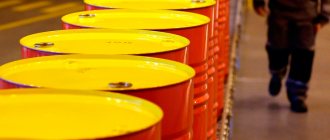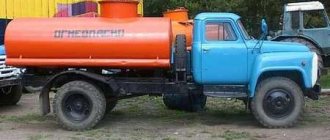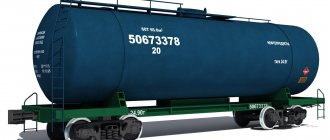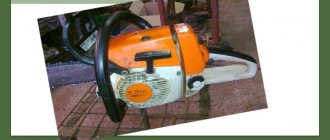Today, the operation of almost all vehicles - cars, airplanes, helicopters, combines and various mechanical devices - depends on fuel. In order to correctly keep records of the issuance of petroleum products, you will need to know how to convert liters of gasoline into kilograms, as well as tons. Do not forget that this is a measure, a definition of volume, and kilograms or tons mean the weight of the substance. Calculations are an important component in the work of accountants and storekeepers when accounting for the fuel mixture. Conversion of units of measurement, arithmetic, which implies the need for certain knowledge, formulas and numbers.
How to calculate fuel consumption by distance?
Multiply your car's consumption per 100 km by the total distance divided by 100. Multiply the resulting figure by the cost of fuel per liter. Example: the distance is 1000 km, the average consumption per 100 km is 5 liters, the cost of fuel is 40 rubles.
Interesting materials:
What is the totem of immortality? What are transport services? What is a trade in in real estate? What is the value of family? What are securities social studies? What is a chain on 1xbet? What is a certificate chain? What is a Flower Moon? What is a course load? What is inventory accounting?
How does the density of a substance affect the calculation of its mass in tons?
The number of cubic meters of petroleum product depends on the ratio of mass to volume. The value, in turn, depends on the quality and manufacturer. A high value of the indicator indicates high-quality raw materials. We have already figured out above that the volume of fuel in liters increases during heating; at sub-zero temperatures, the fuel turns into a jelly-like substance and becomes thick. When recalculating, it will be necessary to take into account the influence of temperature, as well as other influencing factors. To perform specific calculations, you will need to use professional tables containing the required indicators, taking into account the effect of temperature on the fuel.
This volume is in spoons, glasses, jars, etc.
Please note that the weight is calculated based on the volume of the containers and we do not in any way guarantee that they contain the specified volume, however, for approximate measurements in everyday life, the calculated weight is quite applicable.
To determine a more accurate weight, you should use a scale!
Also, keep in mind that some substances can have a destructive effect on the indicated containers and cannot be contained in them in real life.
Tea spoon
18400 pcs.
Tablespoon
5111.1 pcs.
Cup
368 pcs.
Jar 1 l
92 pcs.
Bottle 1.5 l
61.3 pcs.
Jar 3 l
30.7 pcs.
Canister 20 l
4.6 pcs.
This is interesting: How to replace the boot on a VAZ 2109 grenade
Density Tables
The density of a substance is one of the most important physical indicators of an object. It is equal to the ratio of volume to its mass, expressed in kilograms. This characteristic depends on temperature. The higher the temperature, the lower the indicator, and vice versa.
This process is directly related to the phenomenon of thermal expansion. That is, with stable body weight, the volume of the substance increases. There is no need to determine this physical criterion yourself. To do this, just use the density tables.
For example, following them, you can determine that the fuel has the following indicators:
AI-76 - 715 kg/cu.m. meter;
| № | Helpful information |
| 1 | AI-92 - 735 |
| 2 | AI-95 - 750 |
| 3 | AI-98 - 776.5 |
| 4 | summer diesel - 860 |
| 5 | winter diesel - 840 |
| 6 | Arctic diesel oil product - 830 |
Fractional composition of gasoline
All these indicators can only be determined in a laboratory setting. Therefore, it is not possible for consumers to determine the quality of fuel by analyzing the chemical composition.
However, the fluctuations are insignificant. Therefore, standard tables are quite suitable. It is better if the density tables at the enterprise are approved by internal order, and they are the ones that will be used for permanent work. The fact is that in different sources on the Internet, the indicators vary insignificantly.
Interesting facts about gasoline
- Gasoline, unlike water, expands steadily with increasing temperature. Temperature correction – 1 ml per 1 liter with an increase (decrease) in temperature by 1 degree. Accordingly, by filling with colder fuel, you can remove more gasoline from the gas station.
- Gasoline ranks first in the international trade turnover ranking. Humanity uses more gasoline than tea and coffee, which share second place.
- Americans buy $1 billion worth of gasoline per day.
- Venezuela has the cheapest gasoline, only about 5 cents per liter, and the most expensive in Norway and Turkey (data from Bloomberg).
- During Gadaffi's rule in Libya, water was more expensive than gasoline, and fuel cost 14 cents.
- In the 19th century, gasoline was used as an antiseptic.
- A “distant relative” of gasoline, benzoic acid was known to alchemists during the time of Nostradamus. It was extracted from a then popular incense called “benzoy”.
- As a result of direct distillation of oil, only no more than 25% of the original volume of gasoline was previously obtained. More modern processing methods make it possible to obtain up to 80% of high-quality fuel from the original volume of oil.
Features of converting gasoline of different brands from liters to tons
To carry out the arithmetic calculation correctly, you will need to know the table value of the density of the fuel grade. The average density of fuel at room temperature is 0.75 g/l. For detailed measurements, it is necessary to use a correction for ambient temperature in the calculation. This will come in handy when the temperature limits go beyond the accepted limits of 15-20 C. To make the task easier and not waste time on formulas on the Internet, an online calculator program has been developed that performs complex calculations automatically. In the form you need to indicate:
- type of petroleum products;
- volume, mass;
- cost per liter;
Densities of different brands of fuel:
- AI-76 - 1398.6 g/cm3
- AI-80 - 1398.6 g/cm3
- AI-92 - 1360.5 g/cm3
- AI-93 - 1360.5 g/cm3
- AI-95 - 1307.2 g/cm3
- AI-98 - 0.765 g/cm3
Converting any type of fuel from liters to tons is not such a difficult job. It is important to take into account all parameters, external factors and amendments when calculating.
Those who change from a normal machine will be very disappointed. Review of Lada Vesta Cross
In traffic jams the car jerks a lot.
When you press the gas harder, it jumps forward. SW Cross 1.8 Multimedia, robot. Purchased three weeks ago. Traveled 700 km. Gasoline consumption is 9.8 l/100 km (80% of highway driving is on a cruise of 110 km/h at exactly 3000 rpm). Anyone who switches from a normal machine will be very disappointed, as happened to me.
In traffic jams the car jerks a lot. When you press the gas harder, it jumps forward. You have to keep a greater distance. I haven’t yet understood the logic behind enabling the “creeping” mode. If you use this mode while driving, and press the gas, catch up with the car in front, and brake, then when you release the brake, the “creep” does not turn on.
You have to frantically press the brake pedal several times to activate it. On the highway, during smooth acceleration, dips are felt when switching from 1 to 2 and from 2 to 3 speeds.
Suspension and handling are very good. I don’t notice any creaks or any extraneous sounds. Noise protection is good. Heated seat buttons with 3rd adjustment, a separate button for heated front glass available. There is interior lighting in the niches under the radio, in the feet and in the doors. They even put a trunk net measuring 35 x 15 cm
Climate control. At 30 degrees in a traffic jam, I had to turn off the automatic control and turn on the fan to maximum because it wouldn’t turn off and it would get hot.
Wheels and tires. The photo shows the result of hitting a 5 x 5 cm block with the rear wheel at a speed of 80 km/h.
The wheels and tires are very soft, so in my situation both components are scrapped. It is impossible to find original summer tires (Pirelli 205/50 R17 89V) at dealers and on the open market!!
PS The reverse mode started to stick. The camera turns on and when you press the gas the car stalls. The lever is in neutral, you twist the key, the rear view camera immediately turns on, the car does not start (the starter does not turn). After 20 minutes of parking without a key, the glitch was reset.
Something like this.
Read also: Surprisingly, AVTOVAZ met halfway: continuation of the story with a jammed engine 2 days after the purchase of Vesta Cross
www.lada-vesta2.ru
How many grams are in 1 liter of milk?
The density of milk can change depending on temperature and pressure. Question: How many grams are in 1 liter of milk? Answer: 1 gram of milk = 0.000971 liters, 1 liter of milk = 1030 grams.
Interesting materials:
How to distribute the Internet over a local network via Wi Fi? How to distribute Internet from iPad to iPhone? How to distribute Wi-Fi from a tablet? How to divide a number by 10? How to separate a mixture of alcohol and water? How to split a page into two PDF parts? How to smooth out Eco-leather on a stroller? How to smooth a genuine leather skirt? How to smooth a leather sheepskin coat? How to iron a leather jacket?
What is gasoline?
The human mind is constantly in search of something new. Following the advent of steam locomotives and the railway, the time came for the invention of the internal combustion engine.
The first oil refinery was built in 1745, but the process of elementary distillation of oil produced only kerosene, which was used for lighting lamps. Already in 1825, the British physicist Michael Faraday first obtained, as a result of numerous chemical experiments, the first sample of real gasoline. More precisely, the first sample of a hydrocarbon mixture with minimal combustion conditions. Later, gasoline will be considered a mixture of light hydrocarbons with a varied range of boiling points (from +33 to +205ºС).
The specific smell of the substance and the country from which Faraday received raw materials for his experiments prompted the physicist to associate it with the Arabic word meaning “incense.” This is how gasoline got its name.
The creation of a gasoline engine and the first car followed a rocky path. Many inventors have had a hand in what each of us uses almost every day today.
Other meanings
- How much does 15 liters of motor (machine) oil weigh?
- How much does 26 liters of motor (machine) oil weigh?
- How much does 66 liters of motor (machine) oil weigh?
- How much does 133 liters of motor (machine) oil weigh?
| Specific volume is the volume per unit weight of a given substance. Designated - m3/kg. Specific gravity, the reciprocal of specific volume. Its dimension: kg/m3. Molar volume is the specific volume multiplied by the molecular weight of the substance. |
| There are several methods for determining the specific gravity of substances: weighing, pycnometer, hydrometer and others, mainly the method is determined by the state of aggregation of the substance under study, its pressure, temperature and other experimental conditions. |
Geographical position
Bashkortostan is located on the border of Europe and Asia. The territory of the republic is just over 143 thousand square meters. km and covers part of the East European Plain, the mountain system of the Southern Urals and the Trans-Ural uplands. The capital of the region, Ufa, is the largest populated area of the republic; the other cities of Bashkiria are much inferior to it in terms of population and territory size.
The relief of Bashkortostan is extremely diverse. The highest point in the region is the Zigalga ridge (1427 m). Plains and hills are well suited for agriculture, so the population of Bashkiria has long been engaged in cattle breeding and crop production. The republic is rich in water resources; the basins of such rivers as the Volga, Ural and Ob are located here. 12 thousand rivers of various sizes flow through the territory of Bashkiria; there are 2,700 lakes, mostly of spring origin. Also, 440 artificial reservoirs have been created here.
The region has large mineral reserves. Thus, deposits of oil, gold, iron ore, copper, natural gas, and zinc have been discovered here. Bashkiria is located in the temperate zone; there are many mixed forests, forest-steppes and steppes on its territory. There are three large reserves and several nature reserves. Bashkortostan borders on such subjects of the Federation as the Sverdlovsk, Chelyabinsk and Orenburg regions, Udmurtia and Tatarstan.











